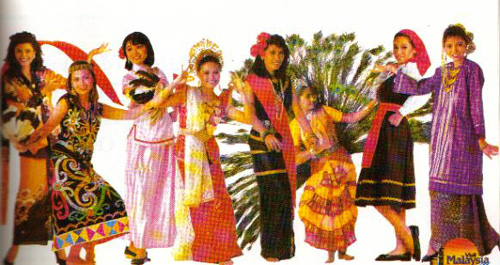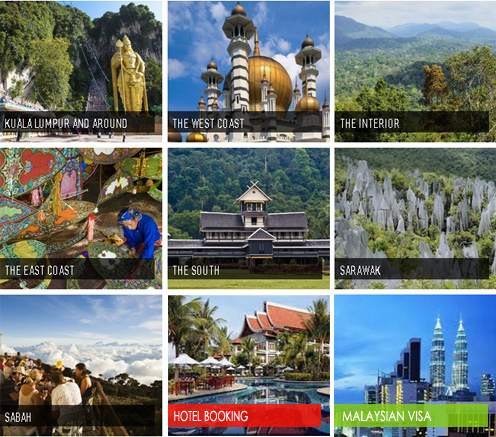|
Malaysia: People
A home to many
cultures...

Visitors to Malaysia will be
fascinated by the multi-culturalism of the country, composing of
Malays, Chinese, Indians and Eurasians, and as well as tribal
communities in the likes of the Kadazandusuns of Sabah and the Iban of
Sarawak. Sabah and Sarawak are two of the thirteen Malaysia states and
are referred to as East Malaysia.
Based on population statistics, Malaysia's population stands at around
23 million today, with about 85% living in Peninsular Malaysia, and
about 15% in both Sabah and Sarawak.
Due to its richness in natural resources and strategic location, close
to the Straits of Malacca, it attracted the Indians, Chinese and
Europeans.Malaysia was under the colony of the British until it gained
independence on 31st August 1957.
Orang Asli
This is a Malay term which means "original people" and encompass all
the aborigines of the nation, which are many and varied, depending on
the area of Malaysia. For example, the Senoi can be found
predominantly in Cameron Highlands. Lately with government aid, many
orang asli have left the forest and sought education and jobs in the
city.
Malays
They are the majority race in Malaysia, comprising of 50-55% of
Malaysia's population. The New Economic Policy (NEP) was set up
somewhere in the late 60s early 70s in an attempt to address the
economic imbalances between Malays and the Chinese (second biggest
racial population in Malaysia), who were perceived as wealthier as a
whole race than the Malays. For the purposes of providing economic
advantages to the Malays, Malays were specifically defined as Muslim,
born of a Malay father and knowing of at least some rudimentary Malay
language. The NEP also provides economic advantages to other natives
of Malaysia, such as orang asli and Muslim peranakan, under the
concept of bumiputra (literally translated as "princely earth" but
meaning native).
The British colonial rulers considered Malay men the closest thing to
gentlemen outside of their own country, due to their warmth, dignity
and politeness. However, they also warned of Malay pirates, who acted
like gentlemen on land, and never hesitated to kill you on the seas.
There are many conflicting hypotheses on the origins of Malays. Some
have said that centuries of Chinese and Indians trading in the mid-way
point of the Malay archipelago had blended into the Malays. Malays
actually come from the Malay archipelago. There are Malays in
Indonesia and Philippines but the majority are in Malaysia which,
prior to the British colonisation was called Tanah Melayu (Malay
Land). Malays did not come from China as some people want to believe.
For starters there are no Chinese words in the Malay language except
the words for food brought in by the Chinese immigrants which the
British brought in by the boatloads to displace the native population.
Malays have been found as far as Cape, Africa but these are Malays
from Malaysia (Malaya previously) who had settled there. There also
Malays in Sri Lanka..
Indians
Penang had been a trading post even before the British colonised it,
hence the local Malay population have mixed Arab or Indian blood. The
Malays who have some Indian blood, being born of Malay mothers married
to an Indian Muslim trader, are called Jawi Peranakan. They also call
themselves "Mamak" and are different from the Indian Muslim community
who don't use Malay as their mother tongue. During British colony,
many non-Muslim Indians came in great numbers probably as indentured
labourers and employed as rubber tappers and plantations labourers.
Most came from south India or Sri Lanka, of Tamil, and small numbers
of Sikh, Parsi, Telugu, Bengali and Keralan.
Known for their tenacity for hard work and preseverance and their
frugal lifestyle, they are now well represented in various
professions, such as doctors, lawyers, engineers.
A subset of this race are the Indian muslims, known as "mamaks", who
emigrated to Malaysia mainly from north India and were of the merchant
class. Some opened restaurants, which thrive these days, with their
ever popular: "roti canai and teh tarik." Some have also married Malay
women and their descendants have been given bumiputra status.
Chinese
Sir Francis Light commented that the Chinese constitute the most
valuable part of the inhabitants in Malaysia as his opinion was that
they could raise revenue "without expense and extraordinary efforts of
government." (Light, Sir Francis. 25 January 1794 as quoted in
Purcell. p 40).
Many Chinese emigrants came to Malaysia during the rife of Manchu
dynasty in 19th-century China. They originally came to work the tin
mines (which boomed in the states of Selangor and Perak) and road and
railway constructions.
Today, they still contribute to a significant portion of Malaysia's
economy. Among the most famous of the Malaysian Chinese would be Mr.
Lim Goh Tong who developed Malaysia's only casino in Genting and all
its attached hotels and other entertainments.
Peranakans
The Chinese Peranakans were first established when Chinese trade
missions established port in Malacca in the early 1400s.
Inter-cultural relationships and marriages were forged between these
traders and local Malay women. Most historically memorable was of
course a Sultan of Malacca marrying Ming Princess Hang Li Poh. With
her, she brought an entourage that settled around what is known in
Malacca these days as Bukit China.
Following this, subsequent generations of Chinese-Malays were known as
Straits Chinese, or Peranakan (means "born here" in Malay). Those who
embraced the Muslim faith are also classified as bumiputras. Today,
though Malacca was the Peranakan centre, large communities also
flourish in Singapore and Penang.
The man is referred to as "baba," whilst the lady is referred to as "nyonya."
The combined phrase of "babanyonya" is used commonly to refer to these
folks and their food, combining the best of Malay and Chinese
favourites amongst many locals and visitors alike.
Eurasians
When Malacca fell to the hands of the Portugese, in the year 1511, in
order to gain control, marriage of Portugese soldiers with local women
was encouraged.
Descendants of the cross-cultural marriages in the 19th and 20th
century are equally reminiscent of their English or Dutch heritage.
Malacca was at one time a Dutch colony also.
During British colonial rule, many bright students were handpicked and
given scholarships (e.g. Rhodes) for tertiary education in the United
Kingdom, Europe, and Australia, and when returning to serve the
government, brought back more than just education, they brought back
their British, European, Australian life partners, giving rise to
mixed parentage children later on in Malaysia.
Today, the topic of race is highly politicized, largely in part to the
existence of the NEP. The media, battling fears of sales loss due to
online news sources, sensationalize the topic even further.
Nonetheless, most of the ordinary citizens of Malaysia live their
day-to-day activities in racial harmony, a characteristic that most of
them take pride in.
Explore Malaysia

Information About Visa
For Malaysia Visa, Air
Ticket & Tour Packages Contact us
|
|